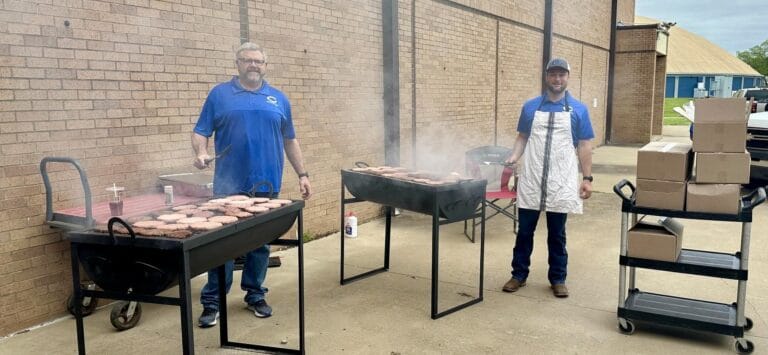Lots of Land in New Subdivisions – But Little Water

By Greg Ritchie
Messenger Reporter
HOUSTON COUNTY – As the old saying goes, “Buyer Beware!” This has been the case with some buyers and potential buyers of properties at some of the subdivisions cropping up around the county. Often large tracts formerly used for logging, the tracts have been subdivided and offered for homesites around the county.
First of all, we need to understand what exactly a “subdivision” is. According to Houston County, it’s anything under 10 acres. The latest subdivisions on the market are above that, meaning they don’t fall under the auspices of county restrictions. According to Consolidated Water, any division of property could be considered a new subdivision.
Rural buyers are used to asking about water when looking at land – they understand the more rural an area, the more likely it might not have any electric or water available. Buyers from bigger cities hear the word, “subdivision,” and may imagine something like a big city suburb, where all amenities are ready to go.
The Messenger was contacted by several concerned residents and decided to look into the matter to see what the situation was. We contacted several of the real estate brokers promoting these tracts, who all gave us the same message: they let potential buyers know when there is no connected water and it is the buyer’s duty to get water facilities installed, on their own.
We were later sent one of the advertisements being used to market one of the properties near Lovelady. The ad promotes the area and at the end states, “With water and electricity conveniently located along the County Road.”
This is 100% factually accurate. So a new buyer should be able to just hook into that line and have full water service, correct?
Not necessarily, said Consolidated Water General Manager Amber Stelly.
“We ask developers to get with us early, before they make that new property line. We can figure out what it’ll cost to sustainably serve that new demand and roll that cost into the price of the land,” Stelly explained. “If we use one of these large subdivisions that does not want to secure water with us – a 300-plus-tract subdivision that would require a whole new well site, tanks, booster pumps, new piping, large piping – each meter requires 200 gallons of storage tank capacity, for example. So now multiply that out and you see what sort of capacity constraint that puts on a water system.”

Creating a connection from road to home could easily run over $100,000 – almost twice the price of the property itself, given the studies and infrastructure this can require. “Still not a problem,” a buyer could think, “We could just dig a well.”
Again, not so fast. Kelton Long from Long Drilling Company told The Messenger the wait for a new well is about one year and costs around $25,000. The wait time for an experienced and carefully dug well has already led other companies to descend on the area, offering wells at a cheaper price, but risking contaminating entire aquifers if they are not done properly or “dry” wells are not correctly plugged.
Long told The Messenger there is plenty of water to accommodate new subdivisions, but 300 separate wells on a 1,000 acre piece of subdivided property will surely have an effect on the amount and quality of water for everyone.
Wanting to see what county officials thought about this situation, The Messenger contacted Houston County Judge Jim Lovell and Precinct Three Commissioner Gene Stokes. Both men had heard of the situation regarding the water and said they were concerned about potential buyers getting themselves into a piece of property where they might not be able to get water.
The issue of how to deal with such a problem is tricky, though. How can the county better regulate these subdivisions and how they are representing some of these properties without affecting a local family who just wishes to subdivide a property in order to leave parcels to family members?
Both men agreed, however, they worry about unsuspecting buyers finding out the water situation only after they had purchased property and the longterm effect this could all have on the county. These subdivisions are essentially popping up and if suddenly filled with new residences, there would certainly be a strain on the water supply and other county services.
Stelly figured it would take over $3 million to provide the necessary water infrastructure for one of these new subdivisions.
“We do look at listings, and we try to intervene and email realtors, if we see something that’s grossly misrepresented. We’ll see, ‘consolidated water is at the road.’ That’s not a false statement. We have a water main at that road that does not get to your tract. And even if it’s on your tract, that could be a transmission line that’s supplying water to another plant. That does not mean there’s capacity available to tap 20 different tracts,” Stelly said.
The Messenger heard about high-pressure sales tactics, selling these lots almost like timeshares. Potential buyers are assured if they do not buy today, they will miss the opportunity of a lifetime. Many of these buyers assume essential services are ready to go and pay high prices for these properties. When they go to secure financing to improve and build on the land, lenders are skeptical, since they paid more than unimproved land might be worth.
Working with the water district before the tracts are even put on the market is the only correct way to do business, according to Nancy Lawrence with Lawrence Realty. She recently helped a client subdivide some property and create a small subdivision. Lawrence said the seller did things right and Stelly praised them for working with Consolidated Water, before the sales process. Lawrence and the seller attended several board meetings and the seller made the investments necessary to make sure the properties would have water ready once sold.
Lawrence said her company always asks potential buyers to call the water district before purchasing, to make sure water will be available on the property.
“We welcome this growth in our county, but it must be handled correctly,” Lawrence said.
With some of the high costs of these properties and the language in the ads implying access to water will not be an issue, how is a buyer to know the difference between a dry property and one of the ones done correctly, such as Lawrence’s client?
Due diligence is the answer, and The Messenger hopes this article will reach potential buyers before they make a costly mistake. Unless you want the land to live in a wood-burning log cabin, ask about water. Many of these companies selling the tracts state they do not and will not speak to the water district, saying this is on the buyer to investigate. Legally and technically, this is correct – but it is easy to understand how buyers can fall into a false sense of comfort when they read terms like “subdivision” and “water conveniently located on county road.”
“This is a huge story in the rural water industry,” Stelly said. “The developers do not want to play ball. Since 2001, we have only had one come to us and do things right and he is the only one I would buy property from, because I know he has secured water rights. It’s such a difficult conversation with buyers when we notify them the tract they’ve purchased is part of what we refer to as a ‘non-compliance subdivision,’ meaning there’s been new property lines created but there’s not been a reservation of capacity to serve it. Essentially, it’s unimproved land and we can serve them, but only with time and a cost.”
Greg Ritchie can be reached at [email protected]






